Employee Engagement and Employee Retention in the Labour Market
Added on 2023-02-07
24 Pages8543 Words93 Views
NAME:
STUDENT NO:
STUDENT NO:

EMPLOYEE ENGAGEMENT AND EMPLOYEE RETENTION IN THE LABOUR
MARKET AND THE POTENTIAL IMPACTS ON ORGANISATIONS ABILITY TO
RECRUIT LABOUR AS A SOURCE OF COMPETITIVE ADVANTAGE THROUGH
TALENT MANAGEMENT.
Abstract:
Fast changes and developments in the labour market are occurring post Covid-19 pandemic,
many of them related to employee engagement and employee retention. They all have substantial
impacts on talent management in multinational corporations. This paper evaluated human
resources strategies on recruiting talented employees with meaningful experiences in order to
engage and retain them.
Keywords: global talent management, COVID 19, human resources, attraction, employee
retention, employee engagement, labour market, home working, e-recruiting, internet,
MARKET AND THE POTENTIAL IMPACTS ON ORGANISATIONS ABILITY TO
RECRUIT LABOUR AS A SOURCE OF COMPETITIVE ADVANTAGE THROUGH
TALENT MANAGEMENT.
Abstract:
Fast changes and developments in the labour market are occurring post Covid-19 pandemic,
many of them related to employee engagement and employee retention. They all have substantial
impacts on talent management in multinational corporations. This paper evaluated human
resources strategies on recruiting talented employees with meaningful experiences in order to
engage and retain them.
Keywords: global talent management, COVID 19, human resources, attraction, employee
retention, employee engagement, labour market, home working, e-recruiting, internet,
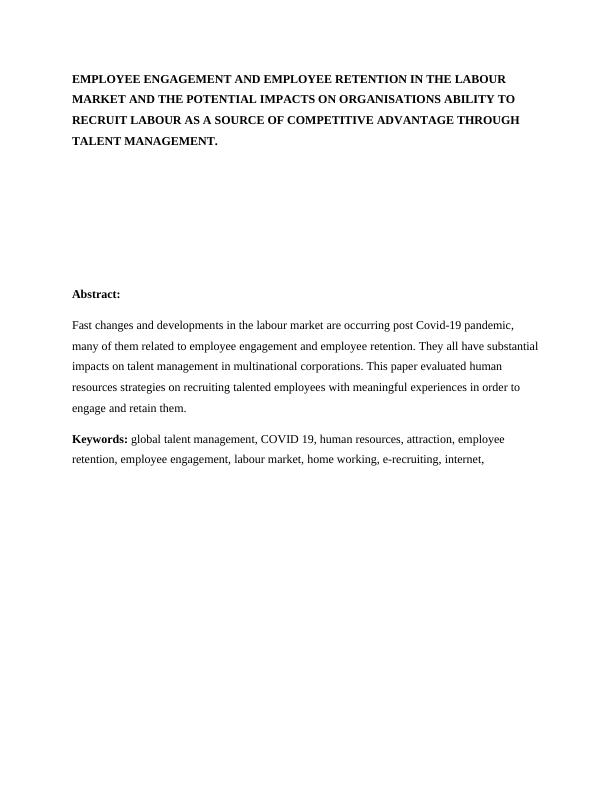
INTRODUCTION
Global talent management aims at developing human resources or human talent base of an
organisation, therefore ensuring that talented individuals are given important roles in an
organization (Blass, 2019). Also, GTM is strategic in nature, as it emphasizes the development of
capabilities and capacities of employees to enable them to meet the future needs and objectives
of a business (Berger and Berger, 2019). Significantly therefore talent management focuses on
developing an effective employee base for the appropriate utilization of talent pool of
organisations (Brant et al, 2018). It can as be defined as the systematic attraction, identification,
development, engagement, retention and deployment of those individuals who are of particular
value to an organization, either because of their high potential for the future or because they are
fulfilling critical roles at present. Talent management is a crucial part of the management and the
effectiveness of the labour market (Gruman & Saks, 2011).
Employee engagement and employee retention are significant player in talent management
across different organisations. According to the office of National Statistic, the total number of
workforce jobs in the UK rose a record 35.8 million, exceeding the pre-coronavirus level of
December 2019 due to more people returning to work and rejoining the labour market. The
highest employment rate figure before was recorded in February 2020, when it reached 76.6%.
During that time, a massive number of 31.68 million people were employed. In recent times, the
governments furlough program, which pays 80% of wages to those who lost their jobs in their
workplaces due to the closure in the pandemic, has largely prevented a surge in joblessness.
The significant rise in high levels of job vacancies over the past few months in UK have gained
the national and organizational attention on the changes in the labour market, recruitment plans,
talent management and other strategies to achieve national and organizational performance. In
this paper, informed recommendations on the appropriateness of the key Human Resource (HR)
strategies and interventions that could be adopted by organizations to deploy labour effectively
in the recent economies.
ATOS is a European multinational information technology service and consulting company
headquartered in Bezons, France. It specializes in hi-tech transactional services, and unified
communications. ATOS is a global leader in digital transformation with 107,000 employees and
Global talent management aims at developing human resources or human talent base of an
organisation, therefore ensuring that talented individuals are given important roles in an
organization (Blass, 2019). Also, GTM is strategic in nature, as it emphasizes the development of
capabilities and capacities of employees to enable them to meet the future needs and objectives
of a business (Berger and Berger, 2019). Significantly therefore talent management focuses on
developing an effective employee base for the appropriate utilization of talent pool of
organisations (Brant et al, 2018). It can as be defined as the systematic attraction, identification,
development, engagement, retention and deployment of those individuals who are of particular
value to an organization, either because of their high potential for the future or because they are
fulfilling critical roles at present. Talent management is a crucial part of the management and the
effectiveness of the labour market (Gruman & Saks, 2011).
Employee engagement and employee retention are significant player in talent management
across different organisations. According to the office of National Statistic, the total number of
workforce jobs in the UK rose a record 35.8 million, exceeding the pre-coronavirus level of
December 2019 due to more people returning to work and rejoining the labour market. The
highest employment rate figure before was recorded in February 2020, when it reached 76.6%.
During that time, a massive number of 31.68 million people were employed. In recent times, the
governments furlough program, which pays 80% of wages to those who lost their jobs in their
workplaces due to the closure in the pandemic, has largely prevented a surge in joblessness.
The significant rise in high levels of job vacancies over the past few months in UK have gained
the national and organizational attention on the changes in the labour market, recruitment plans,
talent management and other strategies to achieve national and organizational performance. In
this paper, informed recommendations on the appropriateness of the key Human Resource (HR)
strategies and interventions that could be adopted by organizations to deploy labour effectively
in the recent economies.
ATOS is a European multinational information technology service and consulting company
headquartered in Bezons, France. It specializes in hi-tech transactional services, and unified
communications. ATOS is a global leader in digital transformation with 107,000 employees and
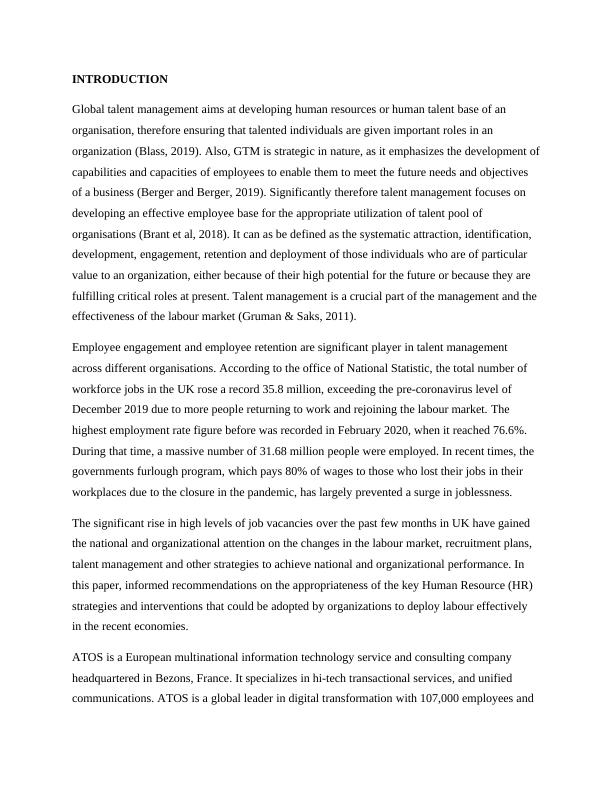
annual revenue of over €11 billion. European number one in cybersecurity, cloud and high-
performance computing, the Group provides tailored end-to-end solutions for all industries in
over 71 countries including the UK (Atos, 2022). ATOS multinational corporations control a
considerable number within its human resource from their operating branches globally. As a
global leader in digital transformation, Atos Company manages over 100000 employees in over
71 nations. The massive operation in the human resource sector suggests its historical growth in
global talent management, hiring workers, processing their data, and keeping a working culture
within the organization (Ghosh et al., 2021, 108). Thus, with its massive operation across the
globe, the organization Atos's digital transformation has technologically evolved since its launch
in 1997.
CONCEPT OF GLOBAL TALENT MANAGEMENT
In the business world today, the strategic resources considered for meeting organisational or
institutional demands to increase competitiveness are talents (Kasemsap, 2017). Prior to
reviewing talent management describing the concept talent becomes necessary (Mohammed et
al, 2017). Naim et al. (2017) explains that talent involves all skills and resources amongst the
human resource element of an organisation which makes them high achievers and enhances their
significant contribution to the organisation. This implies that a talent was a key resource which
ensured that organisations progressed and grew (Ariss et al, 2014). With such ideas about talent,
it therefore became necessary for resources to be effectively harnessed and directed towards
greater purpose and utility. The concept of Talent management becomes important. Aljunaibi
(2014) notes that rather than defining talent management, it was more acceptable to understand
the process, as talent management was more a process than a concept. Talent management
therefore entails the process which the human resource elements are positioned for greater
effectiveness and efficiency (Dahshan et al, 2018). This underscores the fact that without
effectiveness of resources an organisation may not achieve its objectives. Global talent
management is therefore a strategic means were resources and skills were harnessed, developed
and channeled towards achieving the right purposes for the organisation.
performance computing, the Group provides tailored end-to-end solutions for all industries in
over 71 countries including the UK (Atos, 2022). ATOS multinational corporations control a
considerable number within its human resource from their operating branches globally. As a
global leader in digital transformation, Atos Company manages over 100000 employees in over
71 nations. The massive operation in the human resource sector suggests its historical growth in
global talent management, hiring workers, processing their data, and keeping a working culture
within the organization (Ghosh et al., 2021, 108). Thus, with its massive operation across the
globe, the organization Atos's digital transformation has technologically evolved since its launch
in 1997.
CONCEPT OF GLOBAL TALENT MANAGEMENT
In the business world today, the strategic resources considered for meeting organisational or
institutional demands to increase competitiveness are talents (Kasemsap, 2017). Prior to
reviewing talent management describing the concept talent becomes necessary (Mohammed et
al, 2017). Naim et al. (2017) explains that talent involves all skills and resources amongst the
human resource element of an organisation which makes them high achievers and enhances their
significant contribution to the organisation. This implies that a talent was a key resource which
ensured that organisations progressed and grew (Ariss et al, 2014). With such ideas about talent,
it therefore became necessary for resources to be effectively harnessed and directed towards
greater purpose and utility. The concept of Talent management becomes important. Aljunaibi
(2014) notes that rather than defining talent management, it was more acceptable to understand
the process, as talent management was more a process than a concept. Talent management
therefore entails the process which the human resource elements are positioned for greater
effectiveness and efficiency (Dahshan et al, 2018). This underscores the fact that without
effectiveness of resources an organisation may not achieve its objectives. Global talent
management is therefore a strategic means were resources and skills were harnessed, developed
and channeled towards achieving the right purposes for the organisation.
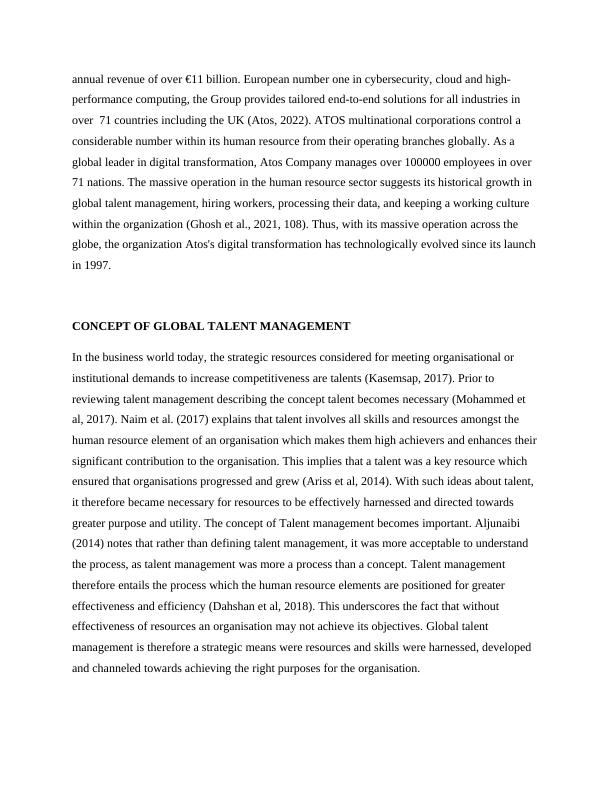
Since, GTM had to do with nurturing, developing, and retaining specific skills in an organisation,
it therefore implied that specific processes and procedures were involved in TM. Kamel (2019),
note that it was difficult to have a definite meaning of GTM as it includes several processes such
as ‘Talent Strategic’, ‘Succession Management’ and ‘Human Resource Planning, which are often
used interchangeably. From the reviewed literature it appears that TM contained three major
processes which include recruitment and selection, training and development and succession
planning. These processes are discussed in the subsequent sections.
HUMAN RESOURCES STRATEGIES IN THE GLOBAL COMPETITIVE MARKET
Due in part to the existence of many drivers of the global talent challenges, there are many
possible HR actions that firms can use in their global talent management initiatives (Beechler
and Woodward, 2009). Matching an accurate diagnosis of a company’s talent management
situation with possible HR actions is a first step in gaining and sustaining a global competitive
advantage that may result from the successful implementation of the correct action. Several
categories of possible HR actions that can be considered by multinational firms to deploy labour
effectively and manage talents include:
Organizational Linkages
Talent management actions can only gain and sustain a global competitive advantage if they are
linked to the actions and strategies of the organization (Nag et al., 2007). Nokia decided to
relocate to Cluji, Romania knowing that the labor force there was both competent and willing to
work at substantially lower wages than the workforce in Bochum, Germany (Ewing, 2008). This
move by Nokia fit well with their business strategy, which was to produce high quality cell
phones in a highly competitive market near a new market place. The HR action reflected a tight
linkage between the firm’s business strategy and its global talent management strategy. This
linkage was possible because Nokia gathered extensive labor market information and then used it
to make an informed decision about where to (re)locate their operations. The business strategy
and talent management strategy development reflected a tight reciprocal linkage (Ewing, 2008).
Attraction and Selection
it therefore implied that specific processes and procedures were involved in TM. Kamel (2019),
note that it was difficult to have a definite meaning of GTM as it includes several processes such
as ‘Talent Strategic’, ‘Succession Management’ and ‘Human Resource Planning, which are often
used interchangeably. From the reviewed literature it appears that TM contained three major
processes which include recruitment and selection, training and development and succession
planning. These processes are discussed in the subsequent sections.
HUMAN RESOURCES STRATEGIES IN THE GLOBAL COMPETITIVE MARKET
Due in part to the existence of many drivers of the global talent challenges, there are many
possible HR actions that firms can use in their global talent management initiatives (Beechler
and Woodward, 2009). Matching an accurate diagnosis of a company’s talent management
situation with possible HR actions is a first step in gaining and sustaining a global competitive
advantage that may result from the successful implementation of the correct action. Several
categories of possible HR actions that can be considered by multinational firms to deploy labour
effectively and manage talents include:
Organizational Linkages
Talent management actions can only gain and sustain a global competitive advantage if they are
linked to the actions and strategies of the organization (Nag et al., 2007). Nokia decided to
relocate to Cluji, Romania knowing that the labor force there was both competent and willing to
work at substantially lower wages than the workforce in Bochum, Germany (Ewing, 2008). This
move by Nokia fit well with their business strategy, which was to produce high quality cell
phones in a highly competitive market near a new market place. The HR action reflected a tight
linkage between the firm’s business strategy and its global talent management strategy. This
linkage was possible because Nokia gathered extensive labor market information and then used it
to make an informed decision about where to (re)locate their operations. The business strategy
and talent management strategy development reflected a tight reciprocal linkage (Ewing, 2008).
Attraction and Selection
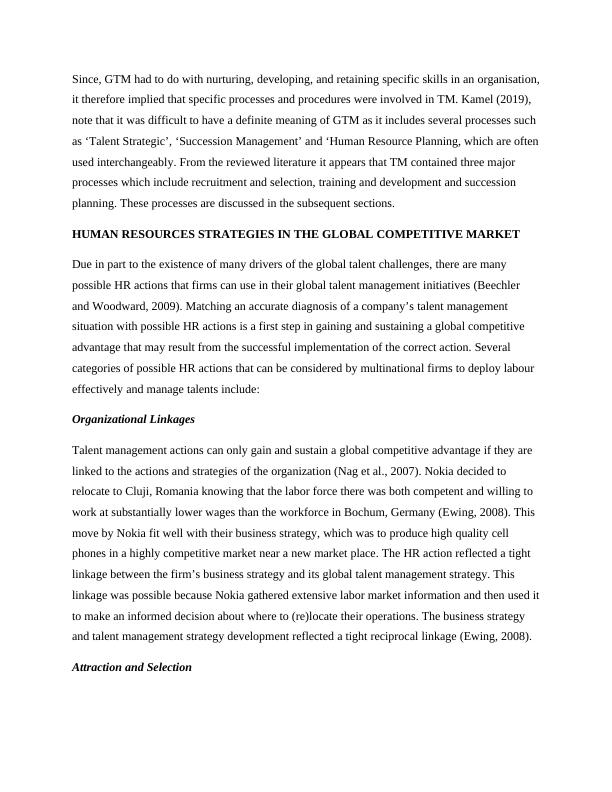
Today organizations are finding that they are having a much more challenging time finding the
workers with the competencies they need to perform a wide variety of jobs, regardless of
worldwide location (Scullion and Collings, 2006). In essence, workers at every level are more
important than ever to multinationals that hope to be competitive, both globally and locally
(Guthridge, et al., 2008). How firms navigate this challenge reflects assumptions they make
about workforce management. Two philosophically distinct approaches to attracting and
selecting talent are evident in the current literature: One approach assumes that some of a firm’s
employees are more valuable than others. Huselid et al. (2009) capture this approach with the use
of alpha terminology, e.g., Type “A” players, Type “B” players, and Type “C” players. For
example, the UK retailer Tesco develops separate recruiting and selection tactics for applicants
for frontline clerks depending upon whether they are straight from school, are part-time or
graduates wanting full-time work. There is a separate website whose materials and language are
tailored to that group (McKinsey, 2008). Tactics used for different groups are based on what the
firm will be most effective and valued by the applicants, not on the firm’s view that some
applicants are more valuable than others.
Training and Development
In locations where competencies fall short of what firms need, training and development
programs can be used to improve the quality of talent available and at the same time increase a
firm’s appeal as an employer. In China, Microsoft uses development and recognition programs
that appeal to first time programmers. Development programs include a rotation to the U.S. and
recognition programs include being selected as a Silk Road Scholar (Chen and Hoskin, 2007).
Multinational firms like Microsoft and Schlumberger also offer attractive career management
opportunities. Schlumberger makes it possible for engineers to achieve recognition and
compensation equivalent to managers while remaining on their engineering career track.
Applying this more broadly, multinational firms can be expected to emphasize internal markets
even more (allowing employees to move around from job to job more freely), with rapid
promotion for the superstars (Wooldridge, 2007).
To address the need for leaders and managers with a global mindset that is broader than
knowledge about the details of local country operations, many Chinese companies have begun
workers with the competencies they need to perform a wide variety of jobs, regardless of
worldwide location (Scullion and Collings, 2006). In essence, workers at every level are more
important than ever to multinationals that hope to be competitive, both globally and locally
(Guthridge, et al., 2008). How firms navigate this challenge reflects assumptions they make
about workforce management. Two philosophically distinct approaches to attracting and
selecting talent are evident in the current literature: One approach assumes that some of a firm’s
employees are more valuable than others. Huselid et al. (2009) capture this approach with the use
of alpha terminology, e.g., Type “A” players, Type “B” players, and Type “C” players. For
example, the UK retailer Tesco develops separate recruiting and selection tactics for applicants
for frontline clerks depending upon whether they are straight from school, are part-time or
graduates wanting full-time work. There is a separate website whose materials and language are
tailored to that group (McKinsey, 2008). Tactics used for different groups are based on what the
firm will be most effective and valued by the applicants, not on the firm’s view that some
applicants are more valuable than others.
Training and Development
In locations where competencies fall short of what firms need, training and development
programs can be used to improve the quality of talent available and at the same time increase a
firm’s appeal as an employer. In China, Microsoft uses development and recognition programs
that appeal to first time programmers. Development programs include a rotation to the U.S. and
recognition programs include being selected as a Silk Road Scholar (Chen and Hoskin, 2007).
Multinational firms like Microsoft and Schlumberger also offer attractive career management
opportunities. Schlumberger makes it possible for engineers to achieve recognition and
compensation equivalent to managers while remaining on their engineering career track.
Applying this more broadly, multinational firms can be expected to emphasize internal markets
even more (allowing employees to move around from job to job more freely), with rapid
promotion for the superstars (Wooldridge, 2007).
To address the need for leaders and managers with a global mindset that is broader than
knowledge about the details of local country operations, many Chinese companies have begun
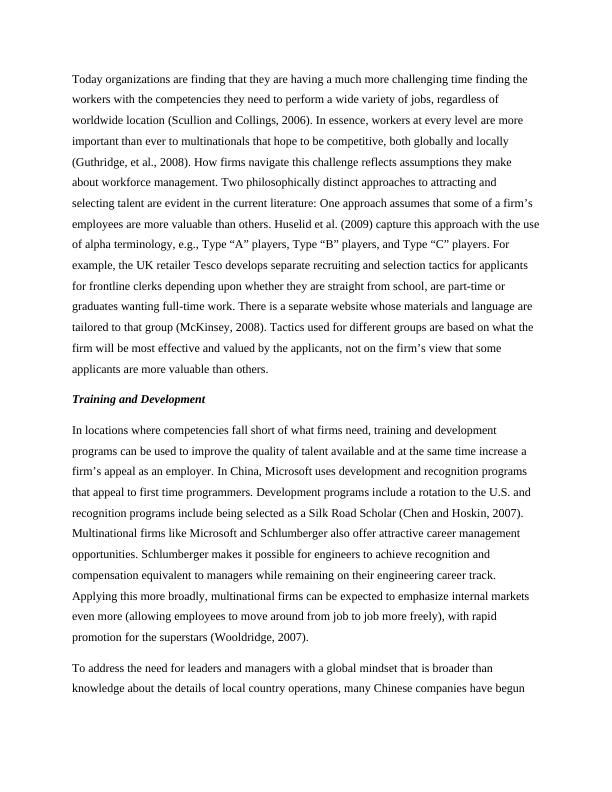
End of preview
Want to access all the pages? Upload your documents or become a member.
Related Documents
Quantitative Data Analysis Report on Rising Issue of Employee Turnover in UKlg...
|12
|2733
|463
Research Projectlg...
|24
|7373
|1
Impact of COVID-19 on Talent Management at Workplace within Mexican Restaurant Chiquitolg...
|24
|7326
|1
Recruitment Strategies in the Post-Covid Eralg...
|9
|1971
|37
Impact of COVID-19 on Employee Engagement, Talent Management, and Organisational Culture: A Case Study of Tescolg...
|12
|3223
|421
Strategic Human Resource Management in the Digital Economylg...
|15
|5096
|361
